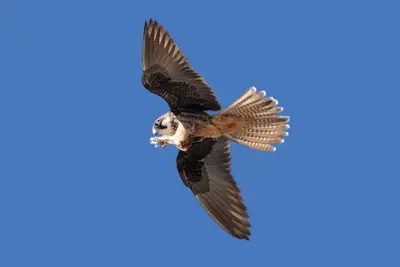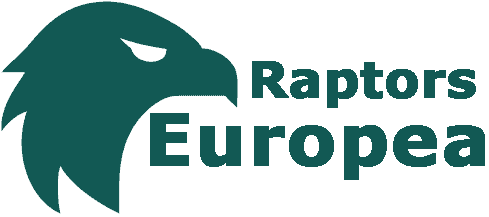Eleonora’s Falcon
(Falco eleonorae)
The Eleonoras Falcon is a fascinating falcon species that only breeds on Mediterranean islands and on the Canary Islands, and nowhere else in the world.

The breeding cycle of Eleonora Falcons coincides with the peak migration of passerine birds crossing the Mediterranean in August and September every year, and they take advantage of this to food supply to raise their chicks.
Outside the breeding season, Eleonora’s Falcons feed mostly on flying insects, and they are long range migrants that spend the winter in Madagascar.
Currently, more than 80% of the entire global population of Eleonora Falcons breed in Greece, making it essential to monitor and protect this population in order to secure the survival of this fascinating falcon species.
Eleonora Falcon facts
Eleonora’s Falcons are highly specialized hunters of migrating passerine birds as they cross the Mediterranean sea in early autumn. After the breeding season they perform a trans-equatorial migration to spend their winter months in Madagascar.
Eleonora’s Falcon size
As a medium sized falcon, the Eleonora’s Falcon is larger than a Kestrel, but smaller than a Peregrine.
- Wingspan: 86-102 cm
- Length: 40-43 cm
- Weight: 330-450 g
The Eleonora’s Falcon is a slender long-winged falcon that soars and hovers with ease at the edge of sea cliffs.
Appearance
The Eleonora’s Falcon resembles a Eurasian Hobby in its overall coloring, but is larger and has significantly longer wings than the Hobby. In addition to this, it rarely shares a habitat with the Hobby in Europe, making it unlikely to confuse these two European falcons. The Eleonora’s Falcon also has a dark morph that is uniformly dark grey, and resembles the Sooty Falcon.

Sexual dimorphism
While female Eleonora’s Falcons are slightly larger than males (similar to most other raptor species), they otherwise look the same.
Lifespan
A maximum lifespan of 16 years has been documented in the wild.
Scientific name and taxonomy
The scientific name of the Eleonora’s Falcon is Falco eleonorae. It is monotypic (meaning there are no other subspecies known), but is related to the Eurasian Hobby (Falco subbuteo) in Europe, and the Sooty Falcon (Falco concolor) in northern Africa and the Middle East.
Eleonora Falcon distribution
The Eleonora’s Falcon is exclusively found breeding on islands in the Mediterranean, as well as on the Canary Islands. The majority of pairs nest on small rocky islands in the Aegean Sea.
Eleonora’s Falcon habitat
During the breeding season, the Eleonora’s Falcon is almost exclusively found on small rocky islands in the Mediterranean sea. It prefers islands that have precipitous cliffs facing the migration routes of small passerine birds. These cliffs not only provide nesting opportunities, but are also ideal for ambushing migratory birds as they approach the island.
Eleonora’s Falcon population size
The global population of the Eleonora’s Falcon is estimated to be between 6,000 and 12,000 pairs, all of which are found in Europe. While the majority of pairs (more than 80%) is found in Greece, the population of Eleonora’s Falcons in the Canary Islands has grown steadily over the past decades, and is now estimated to be about 750 pairs.
Eleonora Falcon behavior
In Europe, the most common behavior of the Elenoras Falcon likely to be observed is soaring and hovering at the edge of the ocean facing cliffs of small rocky islands, where it waits to ambush migrating songbirds.
Feeding and diet
During the breeding season, the Eleonora’s Falcon feeds almost exclusively on small songbirds, predominantly warblers and shrikes, as well as a host of other passerine species. Outside of the breeding season, it switches to feeding on flying insects such as dragonflies and termites (similar to the Eurasian Hobby).
Breeding
Eleonora’s Falcons breed later than any other raptors in Europe, starting in late July, and ending in October. As a result of this timing, their chicks hatch precisely as the migration of songbirds crossing the Mediterranean ocean reaches its peak in August/September.
Nesting usually occurs in colonies nesting in the cliffs of Mediterranean islands. The female lays 2-4 eggs, which are incubated for up to 30 days. After hatching, the young Eleanor Falcons stay in the nest for 36-45 days, and continue to be fed for several weeks after fledging.
Migration
The Eleonora’s Falcon is a long-distance migrant that crosses the equator to spend its winter in Madagascar, as well as the Mascarene Islands in eastern Africa. The Eleanora Falcon passes through both eastern and western Africa during its migration.
Eleonora’s Falcon conservation status
While there have been declines in some local populations, numbers have increased in others, suggesting that the overall population of the Eleanoras Falcon is currently stable. As a result of this, the conservation status of the Eleonora’s Falcon is currently classified as “Least Concern” by BirdLife International.
However, since some local populations are relatively small and disjointed from other populations, the Elonora’s Falcon should be constantly monitored to ensure its population continues to be stable.
Threats
The main threats to Eleonora’s Falcons are illegal hunting in Europe and destruction of suitable habitats in their wintering grounds in Madagascar. Also, it’s important to keep rats from colonising the islands used for breeding, as they are a direct threat to the eggs and chicks of the Eleonoras Falcon.
Additional resources:
- Red-footed Falcon distribution and habitat
- Lanner Falcon distribution
- Barbary Falcon migration behavior
